Shipping
2 - 3 Weeks
Heavy Duty Canvas Tarp - Flame Resistant
• 12 oz. cotton duck with 6 oz. FR wax treatment
• Meets CPAI-84 & NFPA 701 standards
• Water and mildew resistant treatment
• Rustproof brass grommets with 1/2" I.D.
• Double thick, double-stitched hems/seams
Made In The USA
By choosing this product, you're supporting American craftsmanship, local jobs, and ethical manufacturing. Built with care — designed to last.
Shipping
2 - 3 Weeks

Breathable & Antistatic
Why use canvas tarps made from cotton duck in a world full of tarps made from high-tech polymers? The natural fibers and permeable weave give canvas tarps two major advantages:
Breathability: Canvas tarps are treated to be water repellant, but vapor can still pass through. This natural breathability means moisture will not be trapped underneath, avoiding issues with rust, mildew, and mold that fully waterproof tarps can cause.
Antistatic: The cellulose fibers in cotton naturally resist static buildup, so canvas tarps are a great solution for environments where sparks are dangerous.

Control Fire Risk, Maintain Airflow
Stop sparks before they spread. Our treated cotton canvas self-extinguishes in under 2 seconds, which meets the NFPA 701 after-flame limits and confirms the material will resist sustained combustion. Common uses include:
• Welding & grinding screens: Blocks sparks while letting fumes escape.
• Hot-work covers on construction sites: Shields nearby materials during cutting or torching.
• Emergency heat shield: Create quick barriers around boilers, generators, or heaters.
• Farm and heavy-equipment covers: Protects machinery that is still warm after shutdown.
These tarps are typically chosen over vinyl and poly options in situations where breathability is important, as the canvas material allows airflow and helps prevent condensation, while still providing robust fire protection
Advertising Canvas in the 1970s
Humphrys started in 1874 sewing heavy cotton canvas covers for Conestoga wagons, and we’ve been manufacturing canvas tarps ever since. New fabrics and technologies have come along, but there is still a place for a good old-fashioned canvas tarp. This clip from our early 1970s catalog is a great example of its long-standing role in our line.









